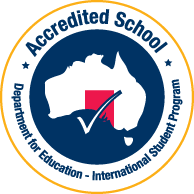LEARNING BEYOND THE CLASSROOM
Environmental Ed and Nature PlayThe Australian Curriculum identifies Sustainability as a cross-curriculum priority, which means it is embedded in all learning areas. Sustainability addresses the ongoing capacity of Earth to maintain all life. Education for sustainability develops the knowledge, skills, values and world views necessary for people to act in ways that
contribute to more sustainable patterns of living.
Our swamp. . . .
The Mount Compass School Swamp is a heritage listed freshwater swamp dominated by dense shrubby vegetation, and forms part of the Fleurieu Peninsula Swamps. The Fleurieu Peninsula Swamps are a unique and endangered ecosystem that provides habitat for many animals and plants. It also plays an important role in improving water
quality and flow.
The 500 m boardwalk provides safe, easy access to the swamp. The
boardwalk meanders through the shrub vegetation, over both wet and
dry areas.
The 4 hectare swamp is home to several endangered species (Coral Fern, Emu Wren, Southern Pygmy Perch and Mount Compass Oak Bush) and the Interpretative Centre provides an outdoor classroom for others schools to also use for Eco-Learning initiative.
A Forest and Swamp program continually evolves as part of our ‘R-12 Environmental Education and Nature Play’ program utilising our unique natural resources. Middle School and Upper Primary students as developed as Environmental Leaders and participate with programs across the Fleurieu with the NRM Board.
The boardwalk was upgraded in 2013, thanks to funding from State
NRM Program Community Grants, the SA Murray-Darling Basin Natural
Resource Management Board and the Australian Government, and
coordination by the Goolwa to Wellington Local Action Planning
Association.
Students work alongside volunteers of Bullock Hill Conservation Park and members of the Green Army to plant seedlings across a hillside of land donated to conservation by local farmers. This land has remnants of endangered Peppermint Box Gum tree groves which are being replanted to increase the biodiversity within the area. Along with a substantial amount of trees, students also planted shrubbery, which will encourage native birds to return and nest in the area. Students are taught how to identify some of the differences between the different Eucalyptus trees and embarked on an informative nature walk around the area.
EXTERNAL LINKS
--
Enquiries:
DL:Mount Compass Area School Info
.
- Daymap - Parent Portal
- Daymap (staff & Students)
- Learnlink


